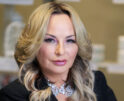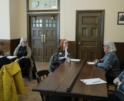
A Climate for Cancer

What effect does the environment have on the rise in breast cancer?
By Mary Anne Dunkin
Looking back, Cherl Osimo isn’t surprised that she developed breast cancer. As a teenager she worked alongside her younger brother – who has since died of colorectal cancer – at the dry cleaning business her parents owned. And as a young woman, she frequently noticed a man dressed like he was “on a mission to Mars” crossing her yard to spray for mosquitoes in a pond behind her Hyannis Port, Mass., property. But it wasn’t until a while after her breast cancer diagnosis in 1991, at age 41, that Osimo began to suspect that her earlier chemical exposures might have endangered her life.
Today, Osimo is outreach coordinator for the Massachusetts Breast Cancer Coalition and a leader of the Silent Spring Institute, a partnership of scientists and activists dedicated to studying the links between the environment and women’s health especially breast cancer. Osimo co-founded the Institute named in homage to Rachel Carson, who wrote the landmark book Silent Spring in 1962 while fighting her own losing battle against breast cancer. A Massachusetts Public Health Department report that showed breast cancer rates on Cape Cod were 21 percent higher than the state average made Osimo want to get involved.
“At first, my motivation was selfcentered,” she recalls.”I had a [young] daughter. I was frightened that she would be diagnosed someday, so my focus was to make a difference.” As years went by, however, she’s realized that breast cancer wasn’t just an issue for her family or even for Cape Cod, but for women everywhere. But while the problem of breast cancer certainly wasn’t unique to Cape Cod, she decided that the location, with its high rate of the disease, would be a perfect place to research environmental factors.
In May of this year, that research led to the publication of “Links Between Environmental Factors and Breast Cancer” in the American Cancer Society’s journal Cancer. The report is the most comprehensive review to date of scientific research on environmental factors that may increase breast cancer risk. It’s findings also appear on the web sites of the Silent Spring Institute (silentspring. org) and Susan G. Komen for the Cure (komen.org), which commissioned the study. The study identifies 216 chemicals that cause breast tumors in animals (see “10 Chemicals to Avoid”). Among them are the dry cleaning solvent perchloroethylene and a number of pesticides, possibly including the one the man in the space suit sprayed near Osimo’s home.
Were these chemicals responsible for Osimo’s breast cancer? Osimo will never know. But she feels certain they played a role, and she knows they are behind the fear she still experiences at medical checkups that might reveal her cancer has returned.
Recognizing the Environment’ s Role
The Silent Spring Institute is one of several major initiatives formed since the mid-1990s to focus on environmental factors and breast cancer around the same time researchers were identifying mutations in two genes, dubbed BRCA1 and BRCA2, that put certain women (and men) at grave risk of breast cancer.
While the discovery of these mutations was an important and in many cases lifesaving discovery, most scientists agree that fewer than 10 percent of breast cancers have a known genetic basis. For the remaining 90 plus percent, there is very likely to be an environmental cause.
“When people look at how diseases are caused, it gets broken down into two items genes and everything else,” says Barbour Warren, Ph.D., re search associate with the Program on Breast Cancer and Environmental Risk Factors at Cornell University. That “everything else” is your environment, and it includes anything you swallow, breathe in or apply to your skin, including foods, alcohol, cigarette smoke, cosmetics and medications.
While the Silent Spring Institute’s report acknowledges the role of certain lifestyle factors, it focuses on chemicals perhaps because these are factors women personally have less control over or assume someone else is taking care of, as when Osimo watched the man in the protective suit cross her property.
“I asked him what he was doing,” she recalls. “He told me he was spraying the pond for mosquitoes and I said, ‘Oh, OK.’ I guess I was just naïve. I guess I just trusted that there was someone making sure that this was OK. I should have known better.”
A Contentious Issue
The issue of industry’s responsibility to make sure things are OK is a contentious one, says Michael Thun, M.D., who heads epidemiological research for the American Cancer Society. “The central reason has to do with uncertainty and divergent views on how strong the evidence is,” he says.
The burden of proof should fall on the chemical industry to show that everything it makes that is ex posed to the public is safe,he explains, but it’s unclear how well animal experiments predict breast cancer risk in humans. There also is uncertainty about the levels of chemicals required to trigger can cerous changes in humans, the effects of different chemicals together, and the possibility that the effects of chemicals may be different for different women depending on their genetic susceptibility. For example, a chemical may have a different effect on an adolescent whose breasts are developing than on a mature woman.
Breast cancer organizations, including Komen, are searching for better methods of testing the effects of chemical com pounds on human mammary tissue. “Ethically we just cannot expose humans to known carcinogens,” says Komen spokesperson Jean Maza. “Yet we need to advance beyond the mouse model stages,” she adds, “to really study what happens in the human body with these compounds.”
With the database of 216 carcinogenic chemicals established, Komen is now funding the development of new research methods to find answers about the effects of environmental exposures, says Dwight Randle, senior scientific adviser for Susan G. Komen for the Cure. “Is there a way we can genetically engineer an animal that would more faithfully represent human biology?” he wonders. “Are there any processes that could mimic the responses in human cells to a particular perturbation that these chemicals represent?”
What You Can Do
While the debate over environmental factors and the development of new testing models will likely last for years, many women like breast cancer patient Anita Jo Canada Egwim are taking measures now to reduce their risk of cancer or its recurrence. A technical college instructor and graduate student who hopes to start an independent school for African-American boys after she receives her Ph.D., Egwim was diagnosed with breast cancer two years ago. Finding no evidence of a genetic cause, doctors told her it was “entirely environmental.”
Concerned that the exposures that caused her cancer might cause it to return, Egwim adopted an organic diet and started researching the products she used on her skin and in her home. Her next step, she says, is to remove the carpeting from her four-bedroom house and replace it with hardwood floors. “Your doctors can treat cancer once you have it, but they can’t keep you from getting cancer in the first place,” Egwim says. “That is up to you.”
This originally appeared in the October 2007 issue of PINK Magazine.
Recommended
-
5 Skin Care Trends: What Profe...April 10th, 2024
-
Is It Time To Change Your Rela...March 20th, 2024
-
Resilience & Transformati...February 20th, 2024
-
Medical Malpractice Lawsuits: ...October 31st, 2023
-
Be Here Now—Two Easy StepsSeptember 19th, 2023















